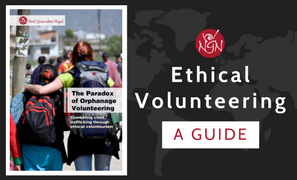Every year, my social media gets flooded with photos of peers posing with children of color, talking about how they had the experience of a lifetime. Voluntourism has persisted for years and it’s unlikely the billion-dollar industry will dry up anytime soon.
Service trips do more harm than good by fueling superiority complexes and damaging stereotypes about disadvantaged communities.
Detrimental to Progress
These trips function to keep people in poverty. Opportunities for foreigners to take care of children has resulted in an increased demand for children in orphanages. Up to 8 million children live in institutions, but over 80% of them have living parents. Orphanages should be the very last resort. Instead of trying to meet demands of foreigners, resources should go towards investments in projects to support families and communities.
Orphanage tourism hurts vulnerable children. It creates attachment disorders from the consistent rotation of visitors coming and leaving. Children under 12 do best in family care rather than institutions, where they are exposed to physical and sexual abuse as well as forced labor.
Since many children go to institutions due to a poor family, the logical solution would be working to reduce poverty, rather than building and funding more orphanages. However, institutions become the solution because governments either don’t have or don’t want to spend the money for anti-poverty work. For orphanages, though, donations are plentiful.
Service trips also put locals out of jobs. A study around mission trips in Honduras found that community members believed the work done by foreigners could have been done by Hondurans who need employment. In the long-term, community members should have control of the structures and systems created and they should run longer than the amount of time the volunteers stay with the community.
A study of Americans who travelled to Honduras after Hurricane Mitch found that the work had made no difference years later. The houses they built cost $30,000, while local organizations could build them for $2,000. If money was contributed, rather than labor, 15 more houses could have been built.
Because volunteers only stay for a short period of time with limited skills, they create unsatisfactory work that hinders progress. These travelers are not teachers. They are not doctors or carpenters or scientists. They are unskilled, young people with enough money to buy a plane ticket.
The Myth of the White Savior
These service or mission trips fit the archetype of white saviorism. While these trips can do some good, they too often fail to hit the mark. They validate notions of privilege and boost the egos of those who need to do some self-reflection. It turns poverty into an attraction — a vacation. You’re turning these communities into zoos to validate your preconceived notion of the world. Further, these mission trips require their volunteers to pay expensive fees to go in the first place. If someone really wants to help, shouldn’t that money get directed to the community itself?
A large lack of self-awareness has turned this industry into a toxic form of modern-day colonialism. Attitudes used to justify colonialism mirror the same behaviors prevalent in voluntourism. The concept of needing to “save” people is dehumanizing. It purports that the locals cannot take care of themselves and need young, wealthy white people to come in and do it for them.
As writer Pippa Biddle found on a trip in high school, her and her classmates’ work was taken down every night and rebuilt by the locals in secrecy. It would have been more cost effective for the orphanage she stayed at to take the money and hire locals to do the work in the first place. Biddle states, “My presence is not the godsend I was coached by non-profits, documentaries, and service programs to believe it would be.”
She notes that, “The work we were doing in both the [Dominican Republic] and Tanzania was good. … It wasn’t the work that was bad. It was me being there.”
Other Options
Why go out of the country when there are people who need help here? Why keep these communities reliant on volunteers, rather than equipping them with the skills necessary to support themselves? Frankly, it’s ridiculous to ignore the numerous socioeconomic issues within your own community to go act like a knight in shining armor abroad for two weeks.
Considering that these trips aren’t going away, there are still ways to enact change sustainably. A two-week time span cannot ever appropriately solve such large and deep-rooted issues, nor create lasting impact. Scaling back the goals for these trips could help, though.
With the pandemic changing how international volunteering functions, many organizations have adopted remote options to help out. Habitat for Humanity, a program that helps build homes and hand washing and health-care facilities, had to operate virtually in 2020, yet many of their planned 800 projects still got finished. People still raised money and contributed to the organization, but local workers took on the task of in-person work.
The pandemic allowed for programs to recognize the importance of domestic workers, as well as keep remote volunteers focused on the work itself.
Before you decide to embark on a service trip, reevaluate your reasons for wanting to go. Maybe you’ve never even considered the damage to the community but recognize that your actions may have negative consequences. Your trip will likely benefit you more than the community you’re visiting, and that’s okay. Just recognize the impacts that your presence has, whether good or bad.






